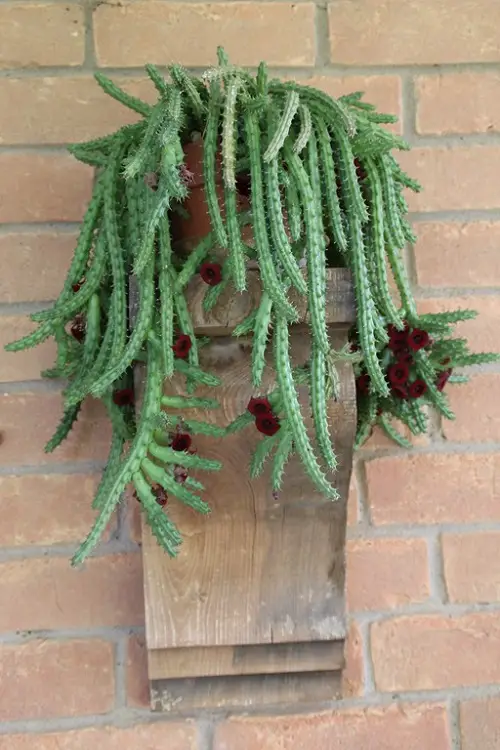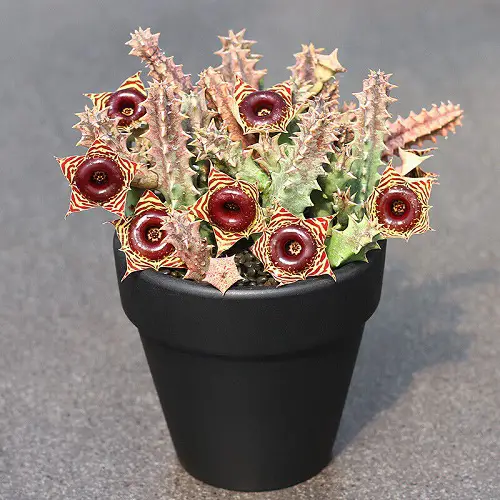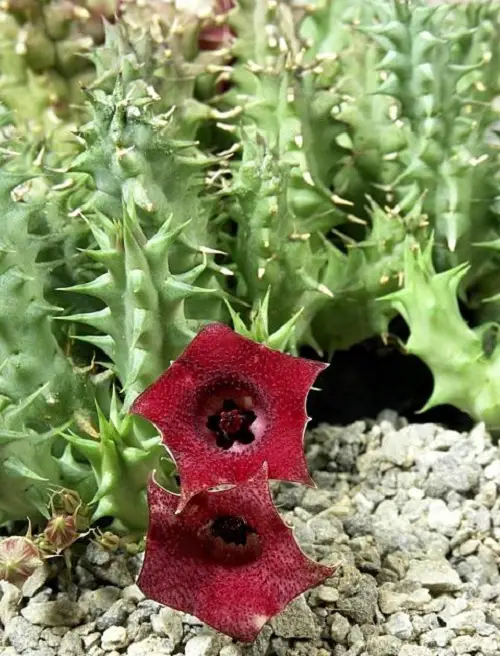Check out our Huernia Macrocarpa Care and Growing Guide that will help you grow the Starfish Flower easily!

Looking for a unique and low-maintenance plant to add to your collection? Look no further than the Huernia Macrocarpa! This fascinating succulent, also known as the Starfish Flower, can be a centerpiece of your indoor or outdoor space!
Botanical Name: Huernia macrocarpa
USDA Zones: 8-12
What is Heurnia Macrocarpa?
Huernia Macrocarpa is a unique succulent plant native to South Africa. It belongs to the Apocynaceae family, which includes milkweed plants. The plant gets its common name, “Dragon Flower,” from its striking appearance, which resembles a dragon’s head with intricate patterns and textures on its petals.
The plant can grow up to 15 cm (6 inches) tall and 30 cm (12 inches) wide. Huernia Macrocarpa has thick, fleshy stems that form clusters of small, triangle-shaped leaves that are only a few millimeters long. The stems are usually green or brown and can have spots or ridges that help the plant camouflage in its natural habitat.
Huernia Macrocarpa blooms during the summer and fall seasons. The star-shaped flowers, which grow from the tips of the stems, have yellow or orange petals. Their unique scent attracts flies and other insects, which help pollinate the plant.
Here is our Mermaid Tail Succulent Care and Plant Information
Heurnia Macrocarpa Pot Size
This low-maintenance succulent prefers to be snug in a small pot. It prefers to be planted in a small pot, around 4-5 inches in diameter, to ensure proper drainage and prevent over-watering. So, choose a cute and compact pot to showcase this stunning succulent!
Requirements for Growing Heurnia Macrocarpa
Sunlight
It grows well in bright but indirect sunlight and prefers at least 5-6 hours of sunlight per day to promote healthy growth and blooming.
However, direct sunlight can scorch its leaves and cause sunburn, so it’s best to provide some shade during the hottest part of the day.
If you’re growing it indoors, place it near a sunny window with plenty of natural light.
Pro Tip: Morning sunlight for 2-3 hours every day can do wonders for its growth.
Soil
This plant requires well-draining soil to prevent waterlogging and root rot. A cactus or succulent mix containing sand or perlite will be perfect for it.
The soil should be loose and crumbly, allowing excess water to drain through easily. Avoid using heavy, clay-based soil that retains too much moisture.
Water
Huernia Macrocarpa is a drought-tolerant plant that requires little water to survive. Water it sparingly, once every two weeks during the growing season, and reduce watering in the winter months.
Over-watering can lead to root rot and kill the plant, so make sure to let the soil dry out completely before watering it again.
Temperature
The plant prefers warm temperatures ranging between 60°F (15°C) to 85°F (30°C). It’s best to avoid exposing it to temperatures below 50°F (10°C) or sudden temperature drops, which can cause stress and affect its growth.
If you’re growing it indoors, make sure to keep it away from cold drafts or air conditioning vents that can lower the temperature.
Read about Sedum Nussbaumerianum Care
Heurnia Macrocarpa Care
Fertilizer
Huernia Macrocarpa doesn’t require frequent fertilization. However, you can feed it with a diluted succulent or cactus fertilizer every two to three months during the growing season, from spring to summer.
Avoid fertilizing during the winter months when the plant is dormant. Also, over-fertilizing can cause salt buildup in the soil and damage the plant’s roots.
Pruning
Huernia Macrocarpa doesn’t require regular pruning, but you can pinch off the tips of its stems to promote bushier growth. If you notice any dead or damaged stems or leaves, trim them off with a clean pair of scissors to prevent the spread of disease.
You can also prune the plant after it has finished blooming to encourage new growth.
Pest and Disease
It is a relatively pest and disease-resistant plant. However, Huernia Macrocarpa can occasionally attract mealybugs, spider mites, and scale insects.
Inspect the plant regularly for any signs of infestation, such as yellowing leaves or white cottony masses on the stems or leaves. To treat the infestation, isolate the plant and spray it with a solution of neem oil or insecticidal soap.
Avoid overwatering the plant, as this can create favorable conditions for fungal diseases like root rot or powdery mildew. If you notice any signs of disease, remove the affected parts immediately and treat the plant with a fungicide if necessary.




